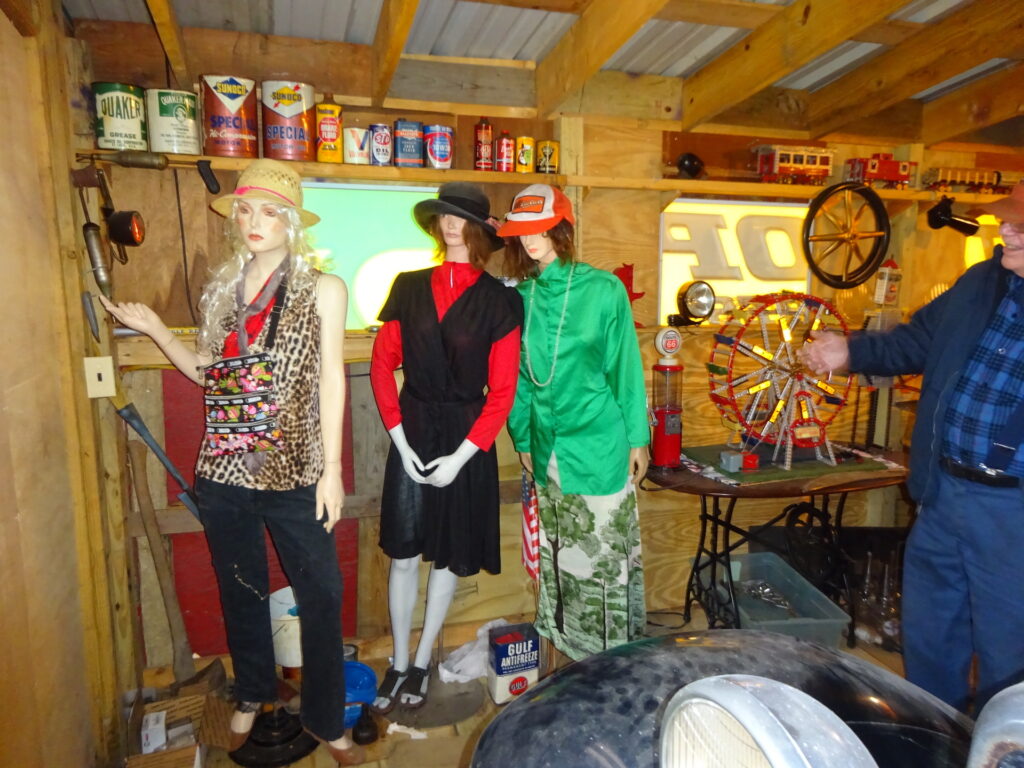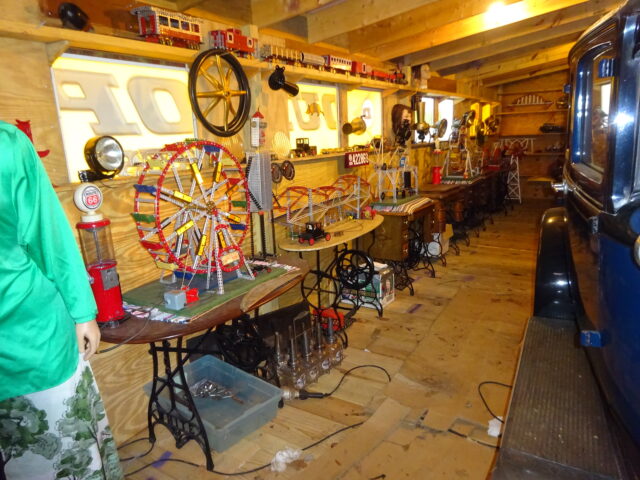We are in the bizarre Disneyland of extraordinary peculiarity with the expressed purpose of buying a Model “A” Ford that was acquired by collector John Smith in 2015. Mr. Smith was a collector extraordinaire of unusual things including, but not limited to, antique cars. His homestead displays his penchant for highway advertising signs which are plastered all over the barns and fences. As well, his blue bottle trees dot the landscape. As we open the doors of the first of the barns we come to there is a gaggle of mannikins dressed in their Sunday best gathered round some Erector set Ferris wheel. In most of the next barns are hundreds of manikins, and manikin body parts. Most are naked, many are fully dressed. “My dad said to always grab up manikins,” so he did. “He also said that about highway signs and traffic lights too,” so he did! It seems that many other things were collected at some point, but unlike typical hoarder’s places, there was some definite kind of ordering system in play. Not that there weren’t piles of junk everywhere. There certainly were. But we did not see piles of garbage associated with hoarders we have encountered in the past. Often those people never let anything that came into the property, garbage included, ever leave the property. This one is different. This can only be described as either a collector, or hoarder’s paradise—someone’s lifetime efforts of collecting virtually anything that tickled their curiosity, and they obsessively collected all of them that they could find. This fellow collected blue bottles, street, road, and traffic signs. He built at least 7 barns to house and display them, and tall picket fences surrounding the property to hang and display them and shield the property from onlookers. Some of the barns are not makeshift farmyard barns. They have finished insides and curtains, paneling, and niceties while others are typical farm barns.

What exactly is a hoarder, and how is that different from a collector? According to the Mayo Clinic, Hoarding Disorder is an ongoing difficulty throwing away or parting with possessions because you believe that you need to save them. You may experience distress at the thought of getting rid of the items. You gradually keep or gather a huge number of items, regardless of their actual value. Hoarding often creates extremely cramped living conditions with only narrow pathways winding through stacks of clutter. Countertops, sinks, stoves, desks, stairways, and all other surfaces are usually piled with stuff. You may not be able to use some areas for their intended purpose. For example, you may not be able to cook in the kitchen. When there’s no more room inside your home, the clutter may spread to the garage, vehicles, yard, and other storage areas. Hoarding ranges from mild to severe. In some cases, hoarding may not have much impact on your life, while in other cases it seriously affects your daily functioning. The mates to these types of people, if indeed they have a mate at all, often share this type of lifestyle. Indeed, the wife did not in this case. Her house is spotless and organized. Never-the-less, you would have to say that this is a serious case of either collecting or something akin to hoarding, and an atypical example at that.
This is what makes these people so very unusual. Martha and John Smith were childhood sweethearts. They married early at 18 and 21. They lived out their lifelong dreams. He was a house sider, she also always worked. They had sufficient income to support this collecting habit. They raised a family. Their house was, and is, neat as a pin inside and out. The property facing the state route in Mentor pretty much resembles other properties except for the 6 ft tall picket fence and various signs neatly hung on the fence. The inner side of the fence, however, presents a different world. They had about 2-3 acres on the property. The son, and now caretaker, John the younger, refers to the whole site as “the barnyard” though it does not resemble a traditional barnyard in any way save for a chicken or two roving about. While we were there, John admonished a chicken standing on one of the Model “T”s for leaving a turd on the car as he wiped it off with his sleeve. C’est La Vie, eh! No, it can be much more accurately described as some sort of eccentric, off-the-wall Disneyland of strange things. John senior collected everything possible. Though there is definite randomness to what lies before you, there is also some distinct sort of organization. Joe built sometimes elaborate barns to house his collections Admittedly there was increasing randomness to what was housed inside these barns bordering on hoarding.
We came to this place in search of a Model “A” Ford that might be for sale. The last time we discovered something like this—in central Ohio– the cars were so far gone that we didn’t even make a bid for either of them. That seller was psychiatrically impaired and out of touch with reality to the point where he insisted that if we just rubbed some kerosene on the cars that they would shine like new and be ready to run. This time, however, the car of interest turned out to be a 1928 Model “A” Ford Phaeton open car, a very desirable car in anybody’s book. It was somewhat apart, but mostly all there and in a dry garage. It looked as if someone had rebuilt the engine and was beginning to reassemble things. Then things were left as they were when last touched. The actual condition of the car was better than we expected. The paint was acceptable, the upholstery was certainly not impeccable but not really that bad either. The engine was obviously being worked on with wrenches and tools on the engine head. The distributor was all apart and broken. The wiring was torn off and, in a ball, and the radiator, fan and light bar were off and leaning on a wall beside the car. One headlight was missing. It was standing on 4 semi-inflated tires. We couldn’t turn the engine over. The early 1928s had an unusual clutch–either could be frozen up. The nature of the rest of the barns and old cars within them suggested that someone had been working on these old cars sporadically in an attempt to get some of them running, but that quite possibly may have been yesterday, 6 months ago, or 16 years ago.
Talking with the younger Smith suggested that the apple may have not fallen far from the tree. He noted that he had been occasionally working on various cars to get something running. Did “occasionally” mean over a period of years? Very possibly! He went on to tell us that he did not live here but spent several months here and in other states where he worked on construction. He would be leaving for Colorado high in the mountains in February. He collected motorcycles, of which there were many new acquisitions scattered throughout the barns. His pickup truck was unusually outfitted with solar panels and a homemade camper in the bed and canoe hanging on the side.
At any rate, we made an offer on the “A” and he said that he would consider it and talk it over with his mother who lived on the premises. On a car like this, with so many unknowns and the engine frozen, you are essentially buying a pile of parts. So, we must be careful and conservative when negotiating.
You never know what the main objective is of these collectors when negotiating with them. They are certainly not actively advertising their wares. Is their main objective to someday sell everything off? Or are they interested in making just enough money to last until the next person inquires about something? Ultimately, the fellow accepted our offer, and our next project will be to try to get my truck and car hauler through the very narrow gateway and steeply graded alley down to the barn where the Model “A” is located—this all before the snow flies.














